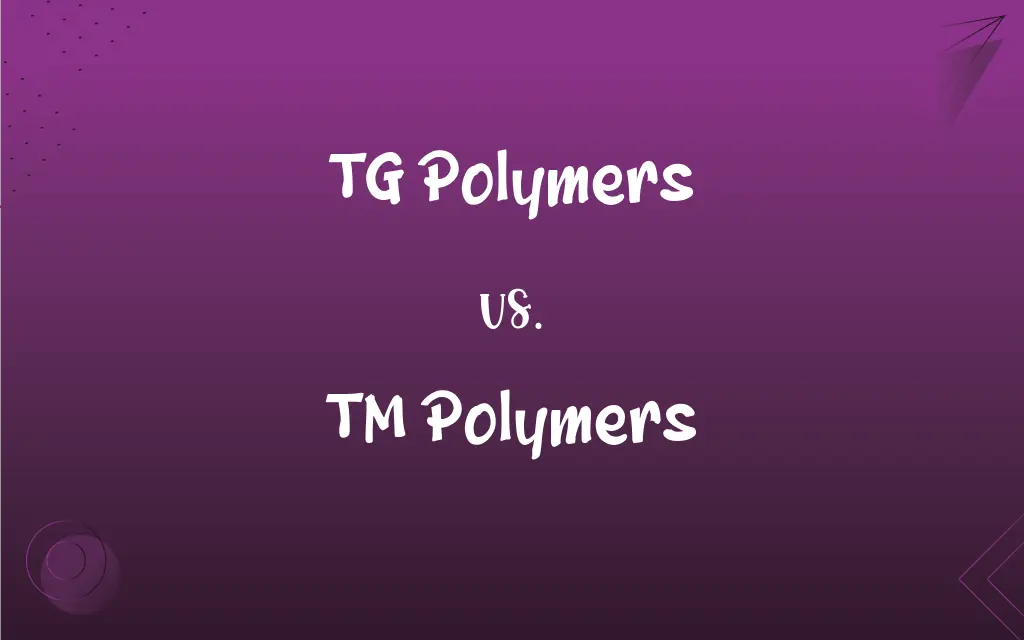TG Polymers vs. TM Polymers: What's the Difference?
Edited by Aimie Carlson || By Janet White || Published on February 18, 2024
Tg (glass transition temperature) polymers refer to the temperature at which a polymer changes from hard and brittle to flexible, while Tm (melting temperature) polymers indicates the temperature at which a crystalline polymer turns into a liquid.

Key Differences
TG polymers are identified by their glass transition temperature, which is a critical thermal property indicating when the polymer changes from a hard, glassy state to a soft, rubbery state. TM polymers, in contrast, are characterized by their melting temperature, a key point where the polymer changes from a solid to a molten or liquid state.
The Tg of TG polymers is often lower than their melting point, making them useful in applications where flexibility is required at lower temperatures. TM polymers, however, are typically chosen for applications that require stability and structural integrity at higher temperatures.
TG polymers can retain their shape and strength up to their Tg, beyond which they may become flexible and less rigid. TM polymers maintain their structural integrity up to their Tm, above which they begin to flow and can be reshaped or reformed.
The measurement of Tg in TG polymers helps in understanding their behavior in various temperature ranges, particularly in applications like coatings and adhesives. For TM polymers, knowing the Tm assists in processing techniques such as molding and extrusion, as it defines the temperature range for effective shaping.
TG polymers are particularly relevant in industries where temperature fluctuations are common, as their properties change significantly at the Tg. TM polymers are crucial in applications requiring a clear transition from solid to liquid state for processing or end-use functionality.
ADVERTISEMENT
Comparison Chart
Defining Temperature
Glass Transition Temperature (Tg).
Melting Temperature (Tm).
State Change
From hard and glassy to soft and rubbery.
From solid to liquid.
Importance
Critical for flexibility and durability at low temps.
Essential for stability and processability at high temps.
Applications
Useful in coatings, adhesives, and flexible materials.
Used in molding, extrusion, and high-temp applications.
Material Behavior
Changes significantly at Tg.
Maintains integrity up to Tm, then flows.
ADVERTISEMENT
TG Polymers and TM Polymers Definitions
TG Polymers
Polymers that soften upon reaching their glass transition temperature.
The TG polymer used in the car's dashboard softened in the summer heat.
TM Polymers
Polymers that melt at a specific temperature, known as their melting point.
The TM polymer began to flow as it reached its melting temperature during processing.
TG Polymers
Suitable for applications requiring a transition from a hard to a soft state.
TG polymers are preferred in these seals for their elasticity at operational temperatures.
TM Polymers
Essential for applications requiring stability at high temperatures.
The TM polymer maintained its form in the high-heat environment.
TG Polymers
Often used where temperature fluctuations are a consideration.
TG polymers are ideal for outdoor applications due to their thermal properties.
TM Polymers
Used in processes like extrusion and molding for their melting characteristics.
TM polymers are ideal for extrusion due to their predictable melting behavior.
TG Polymers
Polymers used for their flexibility and durability at lower temperatures.
The TG polymer coating remained intact despite the cold weather.
TM Polymers
Suitable for high-temperature applications and thermal processing.
In this application, the TM polymer's high melting point is a key advantage.
TG Polymers
Materials characterized by a significant change in physical properties at Tg.
This TG polymer becomes more flexible above its glass transition temperature.
TM Polymers
Characterized by their ability to transition from solid to liquid upon heating.
This TM polymer is used for injection molding due to its clear melting point.
FAQs
What is the key feature of TM polymers?
Their melting temperature (Tm).
Are TG polymers flexible?
Yes, particularly above their Tg.
Do TM polymers flow?
Yes, above their melting temperature.
Can TG polymers be used in cold temperatures?
They can, depending on their Tg.
Can TM polymers be reshaped?
Yes, when heated above their Tm.
Are TG polymers used in adhesives?
Frequently, due to their flexibility.
Can TG polymers be hard and glassy?
Yes, below their glass transition temperature.
What defines TG polymers?
Their glass transition temperature (Tg).
Do TG polymers change properties suddenly at Tg?
Yes, there's a significant change in properties.
What applications are TM polymers used for?
They're used in high-temp and molding applications.
What happens to TG polymers at Tg?
They transition from hard to rubbery.
What is the importance of Tm in TM polymers?
It's crucial for processing and application.
Do TM polymers have a stable state?
Yes, up to their melting temperature.
Where are TM polymers commonly used?
In plastic manufacturing and high-temp environments.
Are TM polymers suitable for high-heat applications?
Yes, due to their higher melting points.
Is the Tm of TM polymers relevant for molding?
Yes, it's critical for proper molding.
Is Tg important for TG polymer selection?
Absolutely, it determines application suitability.
Why is Tm important for TM polymers?
It guides their processing and application.
What industries use TG polymers?
Automotive, electronics, and coatings.
Are TG polymers temperature sensitive?
Yes, particularly around their Tg.
About Author
Written by
Janet WhiteJanet White has been an esteemed writer and blogger for Difference Wiki. Holding a Master's degree in Science and Medical Journalism from the prestigious Boston University, she has consistently demonstrated her expertise and passion for her field. When she's not immersed in her work, Janet relishes her time exercising, delving into a good book, and cherishing moments with friends and family.
Edited by
Aimie CarlsonAimie Carlson, holding a master's degree in English literature, is a fervent English language enthusiast. She lends her writing talents to Difference Wiki, a prominent website that specializes in comparisons, offering readers insightful analyses that both captivate and inform.







































































